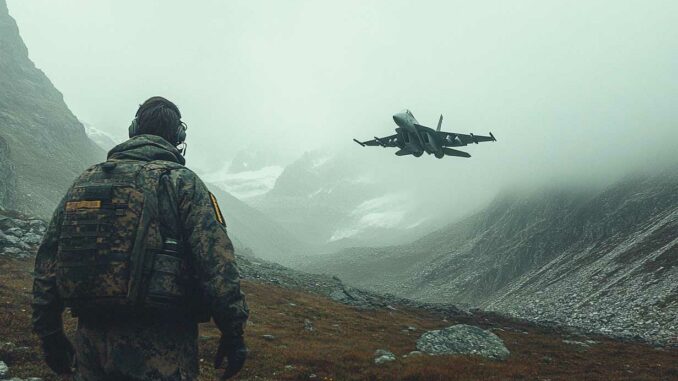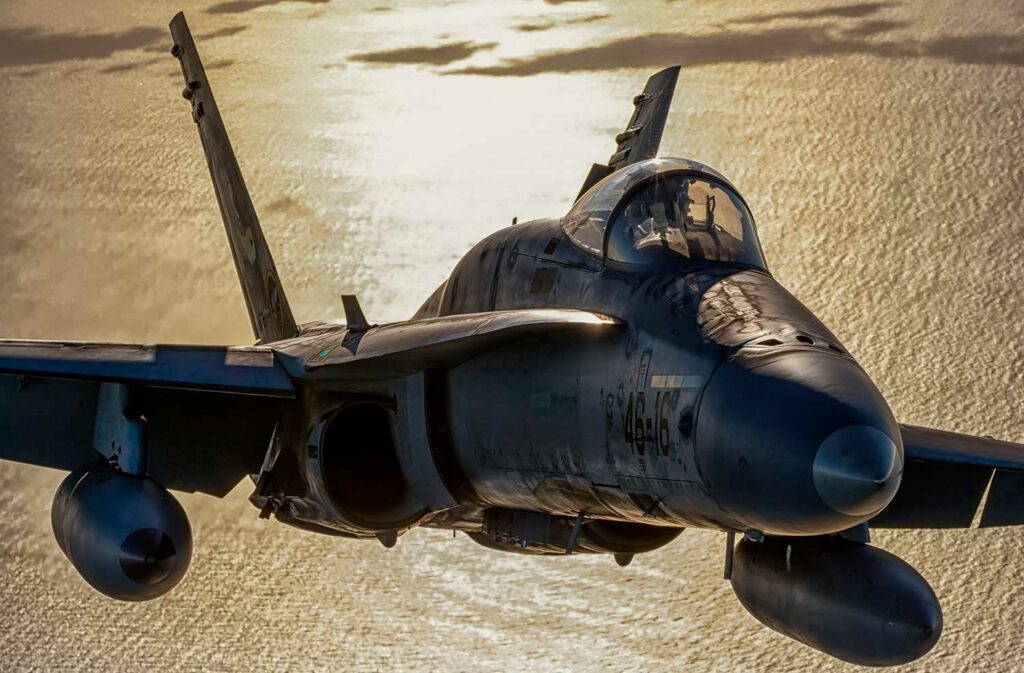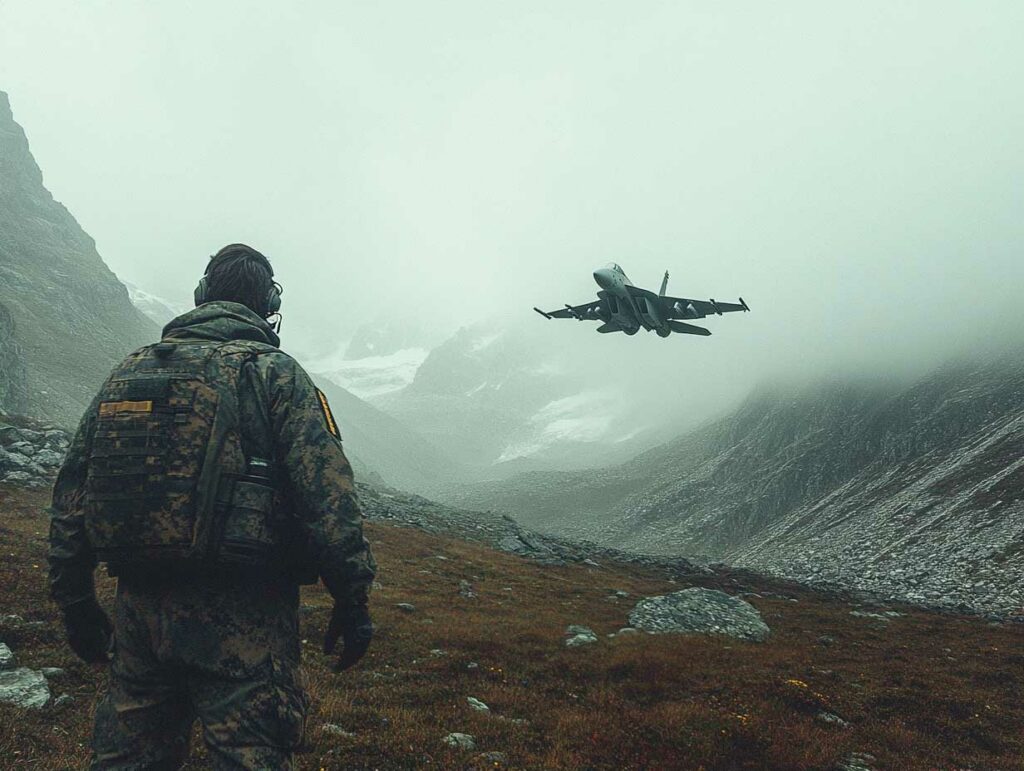
Detailed analysis of real-time coordination between fighter pilots and ground forces during air strikes.
In modern military operations, coordination between fighter pilots and ground forces is crucial to ensuring the effectiveness of air strikes and minimizing risks to ground troops. This coordination relies on precise procedures, advanced technologies, and rigorous training of all involved. The goal is to ensure that air strikes effectively support ground operations in real time, while avoiding friendly fire and maximizing the impact on the enemy.
Tactical coordination between fighter pilots and ground forces
The coordination of air strikes with ground forces relies on a well-defined organizational structure and standardized procedures. Fighter pilots work closely with Forward Air Controllers (FACs) and Joint Terminal Attack Controllers (JTACs). The latter are integrated into ground units and are responsible for directing air strikes by providing accurate target information and liaising with aircraft.
JTACs use procedures such as the “9-Line Brief,” which includes nine lines of essential mission information, including target location, description, GPS coordinates, enemy threats, and specific instructions for the attack. This method allows for clear and concise communication between ground forces and fighter pilots.
Coordination is also facilitated by the use of secure communication networks and data link systems, such as Link 16, which enables real-time sharing of tactical information between different units. These systems ensure a shared situational awareness, which is essential for synchronizing operations.
In addition, airspace deconfliction procedures are put in place to avoid collisions between aircraft and friendly fire. This includes defining specific areas of operation, air corridors, and altitude levels assigned to different platforms.
Tactical coordination is therefore a complex process that requires careful planning, effective communication, and a mutual understanding of the capabilities and limitations of each component of the armed forces.

Communication and targeting technologies in support of air strikes
Technological advances have greatly improved coordination between fighter pilots and ground forces. Modern communication systems enable rapid and secure information exchange, which is essential for conducting operations in real time.
Multiband tactical radios, such as the AN/PRC-117G, offer voice and data communication capabilities, allowing JTACs to transmit accurate information to fighter pilots. These systems are compatible with military communication networks and ensure interoperability between different units.
Data link systems, such as Link 16, enable real-time sharing of tactical information, such as the positions of friendly and enemy units, identified targets, and mission plans. This improves situational awareness and coordination of air strikes.
Advanced targeting systems, such as portable laser designators (e.g., SOFLAM), allow JTACs to mark targets for laser-guided munitions. Fighter aircraft equipped with appropriate sensors can then engage these targets with increased accuracy.
Air platforms, such as MQ-9 Reaper drones, provide real-time surveillance and reconnaissance capabilities, enabling target identification and tracking. The information gathered is shared with ground forces and fighter pilots for optimal strike coordination.
Finally, the integration of command and control systems, such as the Advanced Battle Management System (ABMS), enables effective coordination between different components of the armed forces, facilitating information sharing and rapid decision-making.
Operational procedures for air-to-ground attacks
Air-to-ground attacks are conducted according to strict operational procedures to ensure the effectiveness of strikes and the safety of friendly forces. These procedures are defined in military doctrines, such as JP 3-09.3 “Close Air Support,” which establishes the principles for coordinating close air support.
Close Air Support (CAS) missions are planned according to the needs of ground forces. JTACs identify targets, assess the risk of collateral damage, and coordinate strikes with fighter pilots. There are three types of attack control:
- Type 1: the JTAC has direct visibility of the target and the aircraft, allowing precise control of the attack.
- Type 2: the JTAC cannot see the aircraft or the target, but has sufficient information to authorize the attack.
- Type 3: the JTAC authorizes multiple strikes in a defined area without individual control of each strike.
Before the strike is carried out, a “9-Line Brief” is sent to the fighter pilot, containing essential information about the mission. The pilot confirms receipt and understanding of the data, then proceeds to engage the target according to the instructions received.
After the attack, an assessment of the effects is carried out to determine the effectiveness of the strike and identify any additional actions. This assessment is shared with ground forces and command centers to adjust ongoing operations.
These operational procedures ensure effective coordination between fighter pilots and ground forces, thereby ensuring the success of close air support missions.

Challenges and limitations of real-time coordination
Despite technological advances and established procedures, real-time coordination between fighter pilots and ground forces presents several challenges.
Communication: Complex operational environments can cause interference, signal loss, or incompatibilities between communication systems. This can compromise the transmission of critical information and affect the coordination of attacks.
Response time: Tactical situations evolve rapidly, requiring immediate decisions and actions. Delays in information transmission or decision-making can reduce the effectiveness of air strikes.
Target identification: Distinguishing between friendly forces, civilians, and enemies can be difficult, especially in urban or densely populated environments. Identification errors can result in friendly fire or collateral damage.
Training and education: Effective coordination requires rigorous training of JTACs, fighter pilots, and ground forces. Regular exercises are essential to maintain skills and ensure mutual understanding of procedures.
Interoperability: In multinational operations, differences in doctrine, equipment, and procedures can complicate coordination between allied forces. Efforts are needed to harmonize practices and ensure effective cooperation.
These challenges underscore the importance of careful planning, ongoing training, and continuous improvement of technologies and procedures to ensure effective real-time coordination between fighter pilots and ground forces.
The future of air-ground coordination
Evolving threats and technologies are influencing how fighter pilots coordinate attacks with ground forces. Several trends are emerging to improve this coordination:
Artificial intelligence (AI): The integration of AI into command and control systems enables rapid data analysis, automatic target identification, and decision support for JTACs and fighter pilots.
Advanced communication networks: The development of mesh networks and resilient communication systems improves connectivity between units, even in contested or degraded environments.
Augmented reality systems: Augmented reality helmets and goggles are being developed to improve tactical situational awareness. These systems allow fighter pilots and JTACs to display mission data, target coordinates, or safety zones directly in their field of view in real time. This reduces human error and speeds up decision-making. Lockheed Martin, for example, is developing a helmet for the F-35 Lightning II that integrates tactical data overlay, providing a synthetic view of the battlefield.
Digital interoperability: In the context of multilateral operations, NATO is working to standardize communication systems and data link standards so that different nations can communicate effectively during missions. Joint exercises such as “Bold Quest” test these capabilities in complex scenarios involving fighter jets, ground troops, and drones.
Drones as relays and sensors: UAVs (unmanned aerial vehicles) are no longer used solely for surveillance. Increasingly, they are serving as communication relays or even target designation platforms. In contested areas, an MQ-9 Reaper or Eurodrone can locate, identify, and transmit a target to a Rafale fighter jet, which can then intervene without having to fly over the direct threat.
Integration into the combat cloud: The concept of the “combat cloud” is based on a decentralized architecture for sharing information between all platforms connected to the theater of operations. This includes ground forces, fighter jets, radar systems, satellites, and command centers. The French SCORPION system is gradually integrating these battlefield digitization concepts.
Current innovations are all aimed at reducing the cycle between detection, decision, and action, enabling ever smoother coordination between the sky and the ground. However, technology alone will not guarantee effectiveness: without clear doctrine, constant training, and joint integration, air strikes risk losing their precision and relevance. The human factor remains decisive in the effectiveness of fighter jet flight coordinated with ground troops.
War Wings Daily is an independant magazine.